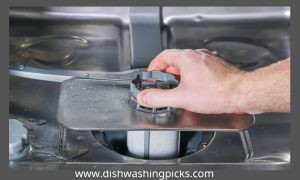Discovering standing water in your dishwasher can be a frustrating experience, but fear not – we’re here to guide you through the process of effectively draining it. A malfunctioning dishwasher not only hinders your kitchen routine but also poses potential issues for the appliance itself. In this comprehensive guide, we’ll walk you through the steps on how to drain standing water in your dishwasher, addressing common causes and offering practical solutions. By the end, you’ll have the knowledge and confidence to tackle this issue, ensuring your dishwasher operates smoothly and your kitchen stays mess-free. Let’s dive into the essential steps to reclaim the efficiency of your dishwasher and enjoy spotless, hassle-free dishwashing.
How to drain standing water in dishwasher
So, you’ve opened your dishwasher, only to find a pool of standing water – not the welcome sight you were hoping for. Don’t worry, we’ve got your back. Follow these straightforward steps to efficiently drain the standing water and get your dishwasher back on track:
Step 1: Pause and Unplug
Before diving in, ensure your safety by turning off the dishwasher and unplugging it. Safety first, always.
Step 2: Assess the Situation
Take a moment to identify any visible debris or potential culprits causing the standing water. Common issues include a clogged filter, a blocked drain hose, or a malfunctioning pump.
Step 3: Tackle the Filter
Most dishwashers have a filter at the bottom. Remove it and check for any food particles or debris. Cleaning the filter is a small task that can make a big difference.
Imagine your dishwasher as a hero battling the tiny villains (debris) to save the day.
Best drinking glasses for dishwasher (Best 7 suggestions)
Step 4: Inspect the Drain Hose
Trace the drain hose from your dishwasher to the sink or garbage disposal. Ensure it’s not kinked or obstructed. A clear path means a smooth flow for the water.
Picture the drain hose as a secret passageway – it needs to be free and clear for the water to escape.
Step 5: Pump Check
Your dishwasher relies on a pump to remove water. Confirm its functioning correctly by checking for any blockages. Give it a gentle clean if needed.
Think of the pump as the heart of your dishwasher, pumping out the water to keep things running smoothly.
Step 6: Manual Water Removal
If there’s still standing water, grab a cup or a sponge to manually remove as much water as possible. Patience is the key here.
Consider this step as giving your dishwasher a helping hand – a teamwork approach.
Step 7: Prevention is the Key
Wrap up by considering preventative measures. Regularly clean the filter, run hot water before starting a cycle, and be mindful of what goes into your dishwasher.
Think of preventative measures as the superhero training for your dishwasher, keeping it in top-notch shape.
By following these steps, you’re not just draining water; you’re revitalizing your dishwasher. Remember, every appliance has its hero moment – today, it’s your dishwasher’s turn.
Choosing the Best Air Gap for Dishwasher
Signs of Standing Water in the Dishwasher

Opening your dishwasher to a pool of standing water can throw off the rhythm of your daily routine. But fear not – let’s troubleshoot the signs and get your kitchen back to its efficient self:
Step 1: The Puddle Predicament
The most obvious sign is, well, a puddle of water at the bottom of your dishwasher. If your once-dry dishes are now swimming, it’s time to investigate.
Picture your dishwasher as a beach – it’s great for cleaning, but you don’t want it flooded!
Step 2: Lingering Suds
Are there stubborn soap suds hanging around after the cycle? This foamy aftermath is a clear indicator of standing water issues.
Imagine the suds as party guests who’ve overstayed their welcome – it’s time for them to leave the dishwasher party.
Best and most effective dishwasher detergent for grease ever
Step 3: Unpleasant Odors
A not-so-pleasant odor wafting from your dishwasher could signal standing water. It’s the dishwasher’s way of saying, “Help, I need a refresh!”
Consider the odor as a distress call – your dishwasher is politely asking for some attention.
Step 4: Resistant Residue
Are your dishes emerging with a film or residue? Standing water can leave a mark on your once-sparkling plates.
Picture the residue as a mysterious map – decoding it leads us to the standing water mystery.
Step 5: Humming Hesitation
A dishwasher that hesitates or makes unusual humming sounds might be struggling with water drainage. Listen closely – your dishwasher is trying to tell you something.
Envision the dishwasher as a musician tuning up – any offbeat sounds are signals that it needs tuning.
Step 6: Incomplete Cycles
If your dishwasher abruptly ends its cycle without draining, it’s a red flag. Your dishes might be only halfway clean, and the water is taking center stage.
Picture your dishwasher as a storyteller – an incomplete cycle means an unfinished tale.
By keeping an eye out for these signs, you become the detective in your kitchen story, solving the mystery of standing water. Your dishwasher has a language of its own, and with these clues, you’re well on your way to deciphering it.
Safety Precautions
Before we embark know how to drain standing water in dishwasher on the journey of resolving your dishwasher’s standing water issue, let’s ensure we prioritize safety. These simple precautions are like the superhero cape that shields you from any potential mishaps:
Step 1: Power Down
Our first superhero move is to power down the dishwasher. Turn it off and unplug it from the electrical outlet. Safety always starts with the flip of a switch.
Think of unplugging your dishwasher as tucking it in for a little safety nap – it’s getting ready for the adventure ahead.
Step 2: The Right Gear
Equip yourself with the right gear – gloves are your trusty sidekicks. They protect your hands from any unexpected surprises and keep you in superhero mode.
Imagine your gloves as the armor that shields you from the kitchen battleground – dishwasher included.
Step 3: A Splash of Caution
Standing water can be slippery, and slippery floors are notorious villains. Place a towel or absorbent cloth around the dishwasher area to catch any potential spills.
Visualize the towel as your loyal sidekick, ready to swoop in and save the day from slippery situations.
Step 4: Mind the Edges
Be cautious when accessing the dishwasher’s interior. Dishwasher edges might be sharp – treat them with respect. It’s a bit like navigating through a secret passage – mind the corners!
Picture the dishwasher edges as castle walls – a bit tricky to navigate, but with care, you’ll conquer any safety concerns.
Step 5: DIY Wisdom
Know your limits. If an issue seems beyond your DIY superhero powers, it’s okay to call in the professionals. Sometimes, even superheroes need backup.
Imagine calling in a repair expert as summoning a superhero ally – they swoop in to save the day when the task requires extra powers.
With these safety precautions, you’re not just fixing a dishwasher; you’re adopting the stance of a safety superhero. Remember, every superhero takes precautions before leaping into action. Now, armed with safety measures, you’re ready for the dishwasher rescue mission.
Maintenance Tips for a Healthy Dishwasher
Maintaining the well-being of your dishwasher is like giving it a spa day – it rewards you with optimal performance and longevity. Let’s dive into the steps to keep your dishwasher in top-notch shape, ensuring it continues to be your kitchen’s unsung hero.
Step 1: Routine Cleaning
Just like any superhero, your dishwasher needs a regular cleaning routine. Wipe down the interior, paying special attention to the door gasket and edges. Imagine this as giving your dishwasher a refreshing shower to wash away any accumulated grime.
Picture the gasket as the superhero cape – keeping it clean ensures it can fly smoothly during every cycle.
Step 2: Filter Checkup
The dishwasher filter plays a crucial role in trapping debris. Give it some love by removing and cleaning it regularly. It’s akin to the filter becoming the unsung hero – quietly doing its job, but a bit of attention keeps it performing at its best.
Think of the filter as the secret agent – periodic check-ins ensure it’s always ready for action.
Step 3: Vinegar Rinse
Once a month, pour a cup of white vinegar into a dishwasher-safe container on the top rack. Run a cycle without any dishes. This superhero move helps banish any lingering odors and keeps your dishwasher smelling fresh.
Consider vinegar as the superhero sidekick – a little assistance that goes a long way in maintaining a pleasant environment.
By incorporating these maintenance steps, you’re not just caring for your dishwasher; you’re nurturing a superhero. Regular upkeep ensures it remains a reliable ally in your kitchen adventures, ready to tackle any dirty dish dilemma.
Conclusion
Congratulations! You’ve successfully navigated the waters of dishwasher troubleshooting and emerged victorious against standing water. By following the steps outlined in this article, you’ve not only drained the water but also empowered your dishwasher to continue its essential role in your kitchen.

